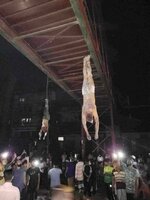If Banga is so great, why are they all sneaking into Europe?Bangladesh has been outperforming its neighbors, it's done fairly well relative to its neighbors:
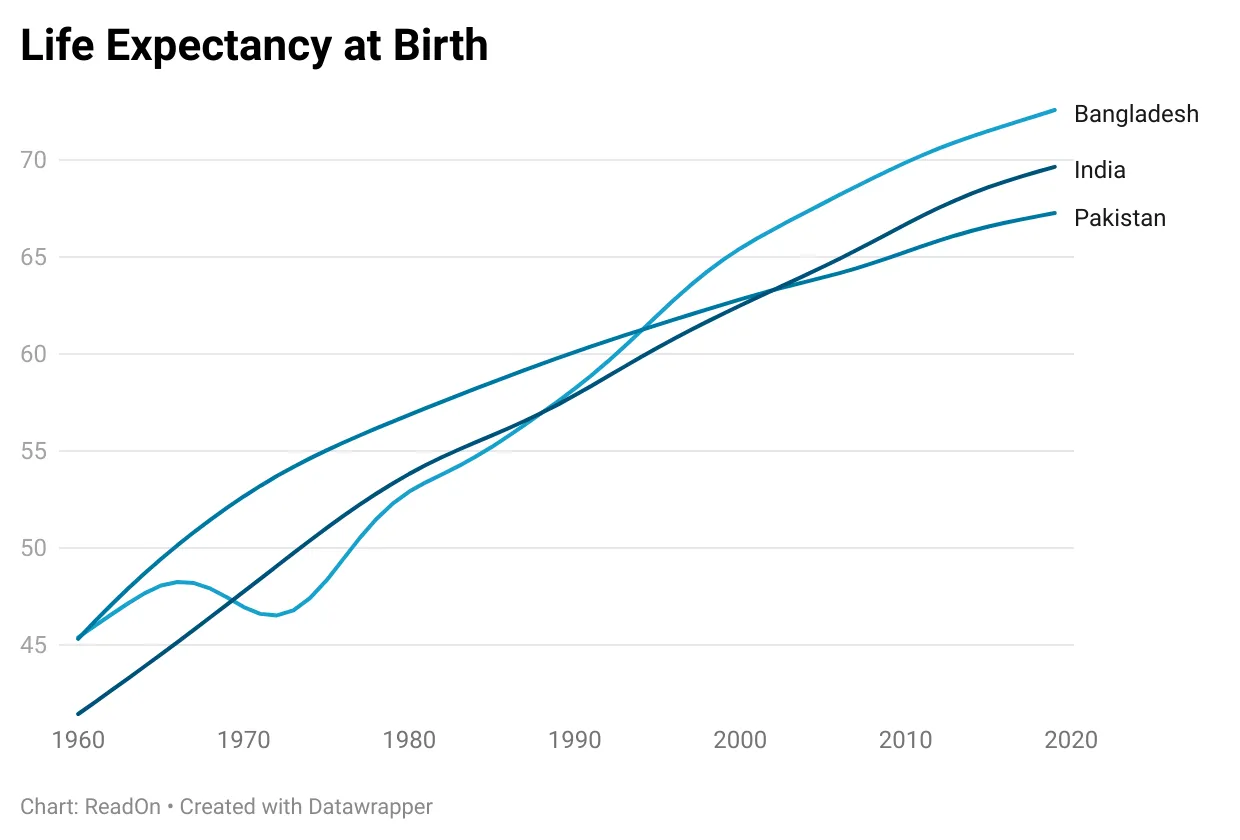

Bangladesh's economic growth faster than India: How?
From a 'hopeless' case to the world's seventh-fastest growing economy. How did Bangladesh do it?readon.substack.com
You are using an out of date browser. It may not display this or other websites correctly.
You should upgrade or use an alternative browser.
You should upgrade or use an alternative browser.
Geopolitics Lounge
- Thread starter Ember
- Start date
Analyzing The Regime Change Sequence That Toppled Bangladesh’s Long-Serving Prime Minister (Andrew Korybko)
Here’s how everything unfolded from the start of this summer’s initially peaceful student-led protests against the judiciary’s reimposition of a contentious government job quota system to the spree of urban terrorism that ultimately forced the country’s long-serving leader to flee for her life to India.Casual news consumers don’t know much about Bangladesh apart from it being a South Asian country that just experienced a regime change, but it’s also the eighth-most-populous country with one of the world’s largest textile industries and a highly geostrategic position. Bangladesh borders India’s Northeast States that are connected to the “mainland” by the “Chicken’s Neck”, which is only 12-14 miles wide at its narrowest, and some of these same states have been troubled by ethno-separatist unrest for years.
Former long-serving Bangladeshi Prime Minister Sheikh Hasina was a de facto Indian ally despite cultivating close ties with China and the US. She shared Indian Prime Minister Narendra Modi’s vision of regional development and thus allowed his country transit rights across hers for facilitating trade with its Northeast States. Moreover, Hasina prevented her country from being used by related militant groups that are designated by Delhi as terrorists, and she also cracked down on religious radicals too.
Although the Bangladeshi economy rapidly grew under her leadership, she resorted to a heavy hand to maintain domestic stability, which upset the increasingly large number of Islamist-inclined youth who considered her government’s legal cases against the opposition to be “anti-democratic lawfare”. Controversial tactics by the security services inadvertently worsened domestic dissent and ultimately led to targeted sanctions by the US, which was already becoming unhappy with her multipolar balancing act.
The past fourteen months saw the worsening of her ties with America after she accused it of fomenting regime change against her in April 2023, followed by Russia expressing concerned in November that it might orchestrate a Color Revolutionduring January 2024’s elections that the opposition boycotted. Less than three months ago, Hasina strongly implied that the US was the Western country that she accused of plotting to carve out a Christian proxy state in the region after she rejected its demand for a base.
Shortly thereafter, the High Court reinstated the contentious government job quota system in late June that had been declared illegal in 2018, which served as the trigger event for mobilizing a large segment of the population to take to the streets against that decision. This movement was initially driven by students but was quickly co-opted by opportunistic members of the opposition, Western-cultivated elements of civil society, and religious radicals, which culminated in her resignation and flight this week:
* 10 January 2024: “The Outcome Of The Bangladeshi & Bhutanese Elections Gives India Strategic Breathing Space”
* 28 January 2024: “The Bangladeshi Opposition’s New Narrative Is Meant To Maximally Appeal To The West”
* 27 May 2024: “Bangladesh Warned About A Western Plot To Carve Out A Christian Proxy State In The Region
* 25 July 2024: “The Unrest In Bangladesh Isn’t A Color Revolution But It Could Still Easily Become One”
* 5 August 2024: “Bangladesh Has Descended Into The Throes Of A Full-Blown Color Revolution”
* 5 August 2024: “What’s The Best Way Forward For Bangladesh After Its Regime Change Surprisingly Succeeded?”
* 6 August 2024: “The Post-Coup Political Violence In Bangladesh Bodes Ill For Its Future Direction”
The preceding analyses document the regime change sequence that took place, which continued after the quota system was scaled back and succeeded due to the rioters gambling that the armed forces wouldn’t resort to lethal force to prevent large numbers of them from storming the parliament and her palace. Average Bangladeshis unconnected to the opposition, religious radicals, and foreign forces also participated in them after being enraged at decontextualized footage of state-on-“protester” violence.
This tactic is characteristic of Color Revolutions and was employed by violent rioters, who many suspect to be the opposition Bangladesh Nationalist Party’s (BNP) banned Jamaat-e-Islami allies, provoking the security services into using lethal force as a last resort to restore safety to the streets. Those individuals were joined the unrest after seeing this footage became unwitting “human shields” for deterring the security services from replicating the aforementioned means out of fear of killing peaceful protesters.
Although social media was banned and a curfew imposed, many still came across that footage and an uncontrollable number of angry citizens then spilled into the streets, thus forcing the security services into the dilemma that was just described and leading to them standing down. Hasina fled once it became clear that she couldn’t count on the security services to protect her and uphold the government that she led. Retributive political violence and attacks against the Hindu minority then followed.
India is concerned about the possibility of Bangladesh reverting to the unfriendly country that it used to be under the BNP, which could see it once again host Delhi-designated terrorist groups as part of a major proxy war against this emerging Great Power. Pakistan’s hatred of India is well known, China is embroiled in a bitter border dispute with India, and the US is furious that India won’t submit to being a vassal by dumping Russia and fighting China on its behalf, so all three have reasons to punish it in this way.
Their interests could therefore converge in Bangladesh to pose serious threats to India’s domestic security and territorial integrity. In that worst-case scenario, the combined effect of their policies – whether coordinated or independently promulgated – would be to sabotage India’s rise as a Great Power, thus representing a major power play in the New Cold War. It’s too early to say whether that’ll happen, but it also can’t be ruled out by India either, which is closely monitoring this neighboring crisis.
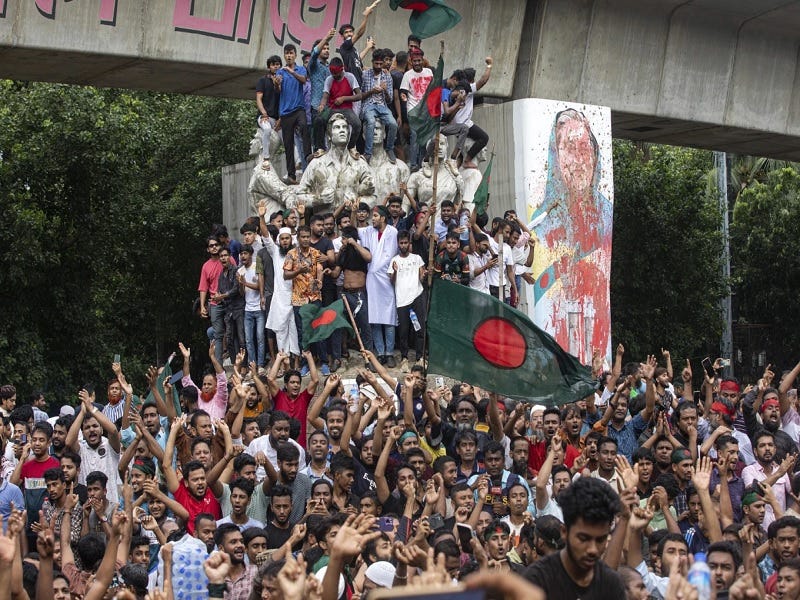
Analyzing The Regime Change Sequence That Toppled Bangladesh’s Long-Serving Prime Minister
Here’s how everything unfolded from the start of this summer’s initially peaceful student-led protests against the judiciary’s reimposition of a contentious government job quota system to the spree of urban terrorism that ultimately forced the country’s long-serving leader to flee for her life...
Say what? Well, from a divide and conquer perspective, it makes sense.Less than three months ago, Hasina strongly implied that the US was the Western country that she accused of plotting to carve out a Christian proxy state in the region
Checks out.after she rejected its demand for a base.
Similar enough departure to Ukraine's Yanukovych after Maidan 2014.Hasina fled once it became clear that she couldn’t count on the security services to protect her and uphold the government that she led.
Sure looks, sounds, and quacks like a color revolution duck.
It's all relative. Yes, Bangladesh is a filthy, desperately poor dump. Also, yes they are growing rapidly, the birth rate is down from formerly excessive levels, and they are way better off than they were. It doesn't have to be one or the other.If Banga is so great, why are they all sneaking into Europe?
forabettertomorrow
Orthodox
Bangladesh is not growing rapidly. They just print funny money inject it in economy et voila magic GDP growth.It's all relative. Yes, Bangladesh is a filthy, desperately poor dump. Also, yes they are growing rapidly, the birth rate is down from formerly excessive levels, and they are way better off than they were. It doesn't have to be one or the other.
Trust me my friend Bangladesh is hell on earth.
Bangladesh is so bad that there are 20 million Bengal people that move to India
I repeat that so you will hear me clearly. 20 million Bengal people move to India for better life. Not only west Bengal provincie in India, also Manipur, Assam ,Sikkim, nagaland.. they are so many that they tilt entire provinces from 5 percent muslim to 40 percent muslim in one generations..
That's how bad Bangladesh is.. They think India is improvement
Last edited:
Muhammad Yunus will be leading the Bangladesh Interim Government. He ran a company called Microcredit where they offer predatory loans to the poor to entrap them. Below, there is a documentary that exposes his scheme.
For decades Microcredit has been hailed as the #1 solution to eradicate poverty. In December 2007, the Danish independent journalist and film maker, Tom Heinemann met with a woman by the name of Jahanara – living in a slum-like house two hours drive outside the Bangladeshi capital, Dhaka. Shortly before the meeting she had sold her house to pay her weekly instalments. For months, she had been intimidated, harassed and abused by members of her loan group and by loan sharks from the various Micro Finance Institutions (MFI) – including Grameen Bank – that had given her the loans. Two years later the film crew went back to investigate if Jahanara had succeeded in getting out of poverty. She hadn’t. “The Micro Debt” also takes a closer look at the 2006 Nobel Peace Prize laureates, Grameen Bank and Mr. Muhammad Yunus. The film reveals a number of secret documents proving how Mr. Yunus back in the mid-90’s transferred USD 100 million – most of it donated as grants by Norway, Sweden, Germany, USA and Canada – to a new company in the Grameen-family in order to avoid tax.
The film crew travelled several times to Bangladesh, and visited some of the most hailed villages in the history of the Nobel laureate Grameen Bank.
In Jobra we met the daughter of the famous loan taker, Sufiya Begun and in “Hillary Village”, where the former US first lady, Hillary Clinton in 1995 came and cheered both Mohammad Yunus and Grameen Bank, the crew meets poor people who gained nothing else but more debt due to microcredit.
Almost each and every loan taker interviewed told the same story. All had taken out multiple loans and all had a hard time trying to pay back their debt. Some had sold their house, others had their tin-sheets pulled off their houses to cover the weekly payments.
“The Micro Debt” was first aired in a special Norwegian version on November 30. 2010 on NRK1 and caught the attention of the world media. In May 2011, Muhammad Yunus was sacked from Grameen Bank. Officially due to age, but according to Mr. Yunus it was this film that led to his downfall.
You can watch the film here - https://tomheinemann.dk/the-micro-debt/
For decades Microcredit has been hailed as the #1 solution to eradicate poverty. In December 2007, the Danish independent journalist and film maker, Tom Heinemann met with a woman by the name of Jahanara – living in a slum-like house two hours drive outside the Bangladeshi capital, Dhaka. Shortly before the meeting she had sold her house to pay her weekly instalments. For months, she had been intimidated, harassed and abused by members of her loan group and by loan sharks from the various Micro Finance Institutions (MFI) – including Grameen Bank – that had given her the loans. Two years later the film crew went back to investigate if Jahanara had succeeded in getting out of poverty. She hadn’t. “The Micro Debt” also takes a closer look at the 2006 Nobel Peace Prize laureates, Grameen Bank and Mr. Muhammad Yunus. The film reveals a number of secret documents proving how Mr. Yunus back in the mid-90’s transferred USD 100 million – most of it donated as grants by Norway, Sweden, Germany, USA and Canada – to a new company in the Grameen-family in order to avoid tax.
The film crew travelled several times to Bangladesh, and visited some of the most hailed villages in the history of the Nobel laureate Grameen Bank.
In Jobra we met the daughter of the famous loan taker, Sufiya Begun and in “Hillary Village”, where the former US first lady, Hillary Clinton in 1995 came and cheered both Mohammad Yunus and Grameen Bank, the crew meets poor people who gained nothing else but more debt due to microcredit.
Almost each and every loan taker interviewed told the same story. All had taken out multiple loans and all had a hard time trying to pay back their debt. Some had sold their house, others had their tin-sheets pulled off their houses to cover the weekly payments.
“The Micro Debt” was first aired in a special Norwegian version on November 30. 2010 on NRK1 and caught the attention of the world media. In May 2011, Muhammad Yunus was sacked from Grameen Bank. Officially due to age, but according to Mr. Yunus it was this film that led to his downfall.
You can watch the film here - https://tomheinemann.dk/the-micro-debt/
Last edited:
Kind of weird how Hasina is suddenly framed as politically opposed to US machinations in the region. Not congruent with reality at all. Google searches on 'US aid to Bangladesh' and 'Hasina official visit where' show how unaligned this talking point is with the nuances of the real world.
For those unwilling to use Google, here is the website of USAID, which is a known de facto US intel asset, claiming a strong 'a strong friendship' with Bangladesh. The website also states that Bangladesh is 'the largest recipient of USAID in Asia'. As for the 23 official visits made by Hasina since 2018 (have to draw the line somewhere), 11 were made to NATO members (UK, USA, Spain, Canada, Australia, Germany, Finland), 6 to regional NATO aligned/ neutral counties like Japan, the UAE, Saudi Arabia, the Maldives and Brunei, 3 official visits were made to India, 2 to China and 1 to Azerbaijan.
Interesting addendum: much of the US aid to the Rohingyas - the weaponized Muslim minority in Myanmar's Arakhan province, has been coming through Bangladesh too. Around 2 billion USD since 2017.
 www.usaid.gov
www.usaid.gov
To add some more counterweight to the one sided posting here on Sheikh Rasina, during her reign Sheikh Hasina has syphoned off more than 63 billion USD which was subsequently moved out of the country, mostly to Swiss bank accounts. Her cronies added another 90 billion to that tally according to the report below.

 www.thedailystar.net
www.thedailystar.net
More than anything else Sheikh Hasina represents third world cronyism, endemic corruption, tyranny, and shameless political opportunism. It's money politics first and foremost, and geopolitics-wise they are willing to work with anyone as long as there is a commission involved. Ideology or moral convictions don't play a role. Domestically anyone that opposed her was met with bullets, the latest round of genuine protestors angry with the country's neo-feudal systems were immediately dubbed 'bandits and miscreants'. A shoot-on-sight policy was almost immediately ordered by Hasina.
Sheikh Hasina is part of Bangladesh's main political dynasty, as her father Mujibur Rahman is Bangladesh's founding father and the former leader of the Awami League. Her family ties are equally indicative of her multivector foreign policy. Sheikh Hasina's sister is a UK citizen. Sheikh Hasina's cousin, Tullip Siddiq, is the current UK Economic Secretary to the Treasury and City Minister. Her daughter, Saima Wazed, is the head of the WHO in South Asia and resides in India and NYC. Her son Sajeeb Wazed studied and lived in the USA for more than 20 years. His wife and daughter are both US citizens, though he denies being a US citizen.
Long story short, Hasina never opposed US influence in Bangladesh or did anything to curtail it. NGOs could register as long as they were willing to pay up. Same for official US agencies - as long as there was a kickback Hasina was ready to play ball.
I don't see many indicators of this being a color revolution at all. Especially not when looking at the outward manifestations of the protests. In general color revolutions share certain characteristics that make it rather easy to identify them. Color revolutions, for instance, are extremely media savvy. The designers are good at optics and have a clear message and certain charisma to mostly younger people at home and abroad. Signage is in English and pre-printed, a bright color gets picked to identify and slick (and often attractive) media savvy youngsters are made the faces of the movement.
When we look at Bangladesh there is none of that. Hardly any pre-printed signage in English, no appeal to foreign media (who here knew this has been going on for 3 weeks already) no slick media campaign, no bubbly bright color, no good looking faces of the revolution, etc.
The first photo is from the 2014 Sunflower Revolution in Taiwan. The second picture is from Myanmar, 2022. Both clear color revolutions. The third photo is Bangladesh 2024.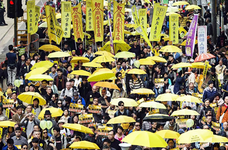
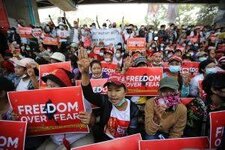
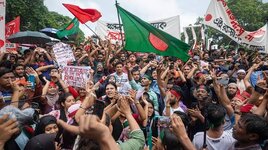
Likewise I don't expect Bangladesh to make any major changes on the grand chessboard. The US probably will improve its position in the country but only slightly. Bangladesh is not suddenly going to opt out of Chinese real estate projects, sign its ports away to the US, cancel Russian grain deals or review its current non-aligned status - just like Pakistan didn't when upstart Imran Khan got capped by the military, even though much of the alt media predicted as much. The only clear loser in all of this will be India but that is at best a regional affair and has a different root cause.[/QUOTE]
For those unwilling to use Google, here is the website of USAID, which is a known de facto US intel asset, claiming a strong 'a strong friendship' with Bangladesh. The website also states that Bangladesh is 'the largest recipient of USAID in Asia'. As for the 23 official visits made by Hasina since 2018 (have to draw the line somewhere), 11 were made to NATO members (UK, USA, Spain, Canada, Australia, Germany, Finland), 6 to regional NATO aligned/ neutral counties like Japan, the UAE, Saudi Arabia, the Maldives and Brunei, 3 official visits were made to India, 2 to China and 1 to Azerbaijan.
Interesting addendum: much of the US aid to the Rohingyas - the weaponized Muslim minority in Myanmar's Arakhan province, has been coming through Bangladesh too. Around 2 billion USD since 2017.
Bangladesh | U.S. Agency for International Development
The United States has long shared a strong friendship with Bangladesh since the country’s independence. It is a partnership driven by common interests that also recognizes Bangladesh as a key U.S. strategic partner in South Asia.
https://en.m.wikipedia.org/wiki/List_of_international_prime_ministerial_trips_made_by_Sheikh_Hasinau
To add some more counterweight to the one sided posting here on Sheikh Rasina, during her reign Sheikh Hasina has syphoned off more than 63 billion USD which was subsequently moved out of the country, mostly to Swiss bank accounts. Her cronies added another 90 billion to that tally according to the report below.

Time to bring back smuggled money
Those who were involved in stealing funds from the country must be held accountable.
More than anything else Sheikh Hasina represents third world cronyism, endemic corruption, tyranny, and shameless political opportunism. It's money politics first and foremost, and geopolitics-wise they are willing to work with anyone as long as there is a commission involved. Ideology or moral convictions don't play a role. Domestically anyone that opposed her was met with bullets, the latest round of genuine protestors angry with the country's neo-feudal systems were immediately dubbed 'bandits and miscreants'. A shoot-on-sight policy was almost immediately ordered by Hasina.
Sheikh Hasina is part of Bangladesh's main political dynasty, as her father Mujibur Rahman is Bangladesh's founding father and the former leader of the Awami League. Her family ties are equally indicative of her multivector foreign policy. Sheikh Hasina's sister is a UK citizen. Sheikh Hasina's cousin, Tullip Siddiq, is the current UK Economic Secretary to the Treasury and City Minister. Her daughter, Saima Wazed, is the head of the WHO in South Asia and resides in India and NYC. Her son Sajeeb Wazed studied and lived in the USA for more than 20 years. His wife and daughter are both US citizens, though he denies being a US citizen.
Long story short, Hasina never opposed US influence in Bangladesh or did anything to curtail it. NGOs could register as long as they were willing to pay up. Same for official US agencies - as long as there was a kickback Hasina was ready to play ball.
Sure looks, sounds, and quacks like a color revolution duck.
I don't see many indicators of this being a color revolution at all. Especially not when looking at the outward manifestations of the protests. In general color revolutions share certain characteristics that make it rather easy to identify them. Color revolutions, for instance, are extremely media savvy. The designers are good at optics and have a clear message and certain charisma to mostly younger people at home and abroad. Signage is in English and pre-printed, a bright color gets picked to identify and slick (and often attractive) media savvy youngsters are made the faces of the movement.
When we look at Bangladesh there is none of that. Hardly any pre-printed signage in English, no appeal to foreign media (who here knew this has been going on for 3 weeks already) no slick media campaign, no bubbly bright color, no good looking faces of the revolution, etc.
The first photo is from the 2014 Sunflower Revolution in Taiwan. The second picture is from Myanmar, 2022. Both clear color revolutions. The third photo is Bangladesh 2024.



Likewise I don't expect Bangladesh to make any major changes on the grand chessboard. The US probably will improve its position in the country but only slightly. Bangladesh is not suddenly going to opt out of Chinese real estate projects, sign its ports away to the US, cancel Russian grain deals or review its current non-aligned status - just like Pakistan didn't when upstart Imran Khan got capped by the military, even though much of the alt media predicted as much. The only clear loser in all of this will be India but that is at best a regional affair and has a different root cause.[/QUOTE]
Last edited:
This is copied straight out of India's info sphere.Analyzing The Regime Change Sequence That Toppled Bangladesh’s Long-Serving Prime Minister (Andrew Korybko)
Here’s how everything unfolded from the start of this summer’s initially peaceful student-led protests against the judiciary’s reimposition of a contentious government job quota system to the spree of urban terrorism that ultimately forced the country’s long-serving leader to flee for her life to India.
Casual news consumers don’t know much about Bangladesh apart from it being a South Asian country that just experienced a regime change, but it’s also the eighth-most-populous country with one of the world’s largest textile industries and a highly geostrategic position. Bangladesh borders India’s Northeast States that are connected to the “mainland” by the “Chicken’s Neck”, which is only 12-14 miles wide at its narrowest, and some of these same states have been troubled by ethno-separatist unrest for years.
Former long-serving Bangladeshi Prime Minister Sheikh Hasina was a de facto Indian ally despite cultivating close ties with China and the US. She shared Indian Prime Minister Narendra Modi’s vision of regional development and thus allowed his country transit rights across hers for facilitating trade with its Northeast States. Moreover, Hasina prevented her country from being used by related militant groups that are designated by Delhi as terrorists, and she also cracked down on religious radicals too.
Although the Bangladeshi economy rapidly grew under her leadership, she resorted to a heavy hand to maintain domestic stability, which upset the increasingly large number of Islamist-inclined youth who considered her government’s legal cases against the opposition to be “anti-democratic lawfare”. Controversial tactics by the security services inadvertently worsened domestic dissent and ultimately led to targeted sanctions by the US, which was already becoming unhappy with her multipolar balancing act.
The past fourteen months saw the worsening of her ties with America after she accused it of fomenting regime change against her in April 2023, followed by Russia expressing concerned in November that it might orchestrate a Color Revolutionduring January 2024’s elections that the opposition boycotted. Less than three months ago, Hasina strongly implied that the US was the Western country that she accused of plotting to carve out a Christian proxy state in the region after she rejected its demand for a base.
Shortly thereafter, the High Court reinstated the contentious government job quota system in late June that had been declared illegal in 2018, which served as the trigger event for mobilizing a large segment of the population to take to the streets against that decision. This movement was initially driven by students but was quickly co-opted by opportunistic members of the opposition, Western-cultivated elements of civil society, and religious radicals, which culminated in her resignation and flight this week:
* 10 January 2024: “The Outcome Of The Bangladeshi & Bhutanese Elections Gives India Strategic Breathing Space”
* 28 January 2024: “The Bangladeshi Opposition’s New Narrative Is Meant To Maximally Appeal To The West”
* 27 May 2024: “Bangladesh Warned About A Western Plot To Carve Out A Christian Proxy State In The Region
* 25 July 2024: “The Unrest In Bangladesh Isn’t A Color Revolution But It Could Still Easily Become One”
* 5 August 2024: “Bangladesh Has Descended Into The Throes Of A Full-Blown Color Revolution”
* 5 August 2024: “What’s The Best Way Forward For Bangladesh After Its Regime Change Surprisingly Succeeded?”
* 6 August 2024: “The Post-Coup Political Violence In Bangladesh Bodes Ill For Its Future Direction”
The preceding analyses document the regime change sequence that took place, which continued after the quota system was scaled back and succeeded due to the rioters gambling that the armed forces wouldn’t resort to lethal force to prevent large numbers of them from storming the parliament and her palace. Average Bangladeshis unconnected to the opposition, religious radicals, and foreign forces also participated in them after being enraged at decontextualized footage of state-on-“protester” violence.
This tactic is characteristic of Color Revolutions and was employed by violent rioters, who many suspect to be the opposition Bangladesh Nationalist Party’s (BNP) banned Jamaat-e-Islami allies, provoking the security services into using lethal force as a last resort to restore safety to the streets. Those individuals were joined the unrest after seeing this footage became unwitting “human shields” for deterring the security services from replicating the aforementioned means out of fear of killing peaceful protesters.
Although social media was banned and a curfew imposed, many still came across that footage and an uncontrollable number of angry citizens then spilled into the streets, thus forcing the security services into the dilemma that was just described and leading to them standing down. Hasina fled once it became clear that she couldn’t count on the security services to protect her and uphold the government that she led. Retributive political violence and attacks against the Hindu minority then followed.
India is concerned about the possibility of Bangladesh reverting to the unfriendly country that it used to be under the BNP, which could see it once again host Delhi-designated terrorist groups as part of a major proxy war against this emerging Great Power. Pakistan’s hatred of India is well known, China is embroiled in a bitter border dispute with India, and the US is furious that India won’t submit to being a vassal by dumping Russia and fighting China on its behalf, so all three have reasons to punish it in this way.
Their interests could therefore converge in Bangladesh to pose serious threats to India’s domestic security and territorial integrity. In that worst-case scenario, the combined effect of their policies – whether coordinated or independently promulgated – would be to sabotage India’s rise as a Great Power, thus representing a major power play in the New Cold War. It’s too early to say whether that’ll happen, but it also can’t be ruled out by India either, which is closely monitoring this neighboring crisis.

Analyzing The Regime Change Sequence That Toppled Bangladesh’s Long-Serving Prime Minister
Here’s how everything unfolded from the start of this summer’s initially peaceful student-led protests against the judiciary’s reimposition of a contentious government job quota system to the spree of urban terrorism that ultimately forced the country’s long-serving leader to flee for her life...korybko.substack.com
The only big loser so far is India, as Hasina's Awami League was close to India and the anti government protests have taken on a clear anti India character.
The Indian infosphere has been in meltdown mode for over a week now, with copes and spins of all sorts being deployed. Allegedly the US is so scared of India (which according to these same individuals was supposed to be a Superpower by 2020) extending its sphere of influence into South East Asia that they are now contemplating manufacturing a new Christian majority state in Bangladesh/Myanmar/India to physically block India from doing so.
This is of course grotesque drivel as India has recently moved towards multilateral Transatlantic organizations due to its longstanding animosity with China. The US, on the other hand, is solely occupied with containing China in the Indo-Pacific.
Anyway, this new state is supposed to encompass the Chittagong hills in Bangladesh, the parts of the Indian Seven Sister States that are majority Christian and the majority Christian Shin area of Myanmar.
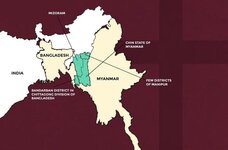
As an aside these mostly Hindutva oriented individuals also accuse US of engineering the Kuki-Meitei conflict in Manipur. The Kukis being tribal Christians and the Meitei Hindus. This too doesn't make sense, as it's a tribal conflict going back hundreds of years, worsened by lingering discrimination of the Meitei majority through remnants of India's Congress Party's legislation and the BJPs Hindutva ideology becoming more rooted amongst the Meitei majority - who are rightfully asking themselves why they are actively discriminated against on their own turf.
Last edited:
Despite Hasina fleeing and a new caretaker government taking office there is still a lot of unrest and violence in Bangladesh. Over the last few days there has been a lot of violence against Awami League members and officials. One of the top dogs of the Party got burned alive in his house. Day of the rope vibes, there are a lot of people with grudges.
Awami League members a couple of days ago.
Likewise there is increasing violence against Bangladesh's Hindu minority. First many said that this was an Indian fake news ploy to slander the new government, but increasingly there are videos of Hindu properties destroyed and Hindus killed.
The protests were made up of several factions and ideologies. The main power block is the military. They dropped support for Hasina after seeing the mood in the country shift and that's when she fled.
Other groups are the student protest movement, the political parties like the BNP and Jatiya and the Islamists.
The transition of power might not go flawless. There is especially a lot of worry that the Islamists might get organized and start making moves. In general all Bengali parties tacitly agree on a zero tolerance attitude vis a vis Islamists. Under Hasina all Islamists parties were banned and many organizers imprisoned or killed.
All in all the military will have to drop the hammer in 1-2 weeks and restore order. If they fail to do so things might get ugly.
Awami League members a couple of days ago.
Likewise there is increasing violence against Bangladesh's Hindu minority. First many said that this was an Indian fake news ploy to slander the new government, but increasingly there are videos of Hindu properties destroyed and Hindus killed.
The protests were made up of several factions and ideologies. The main power block is the military. They dropped support for Hasina after seeing the mood in the country shift and that's when she fled.
Other groups are the student protest movement, the political parties like the BNP and Jatiya and the Islamists.
The transition of power might not go flawless. There is especially a lot of worry that the Islamists might get organized and start making moves. In general all Bengali parties tacitly agree on a zero tolerance attitude vis a vis Islamists. Under Hasina all Islamists parties were banned and many organizers imprisoned or killed.
All in all the military will have to drop the hammer in 1-2 weeks and restore order. If they fail to do so things might get ugly.
Kind of weird how Hasina is suddenly framed as politically opposed to US machinations in the region. Not congruent with reality at all. Google searches on 'US aid to Bangladesh' and 'Hasina official visit where' show how unaligned this talking point is with the nuances of the real world.
For those unwilling to use Google, here is the website of USAID, which is a known de facto US intel asset, claiming a strong 'a strong friendship' with Bangladesh. The website also states that Bangladesh is 'the largest recipient of USAID in Asia'. As for the 23 official visits made by Hasina since 2018 (have to draw the line somewhere), 11 were made to NATO members (UK, USA, Spain, Canada, Australia, Germany, Finland), 6 to regional NATO aligned/ neutral counties like Japan, the UAE, Saudi Arabia, the Maldives and Brunei, 3 official visits were made to India, 2 to China and 1 to Azerbaijan.
Interesting addendum: much of the US aid to the Rohingyas - the weaponized Muslim minority in Myanmar's Arakhan province, has been coming through Bangladesh too. Around 2 billion USD since 2017.
Bangladesh | U.S. Agency for International Development
The United States has long shared a strong friendship with Bangladesh since the country’s independence. It is a partnership driven by common interests that also recognizes Bangladesh as a key U.S. strategic partner in South Asia.www.usaid.gov
https://en.m.wikipedia.org/wiki/List_of_international_prime_ministerial_trips_made_by_Sheikh_Hasinau
To add some more counterweight to the one sided posting here on Sheikh Rasina, during her reign Sheikh Hasina has syphoned off more than 63 billion USD which was subsequently moved out of the country, mostly to Swiss bank accounts. Her cronies added another 90 billion to that tally according to the report below.

Time to bring back smuggled money
Those who were involved in stealing funds from the country must be held accountable.www.thedailystar.net
More than anything else Sheikh Hasina represents third world cronyism, endemic corruption, tyranny, and shameless political opportunism. It's money politics first and foremost, and geopolitics-wise they are willing to work with anyone as long as there is a commission involved. Ideology or moral convictions don't play a role. Domestically anyone that opposed her was met with bullets, the latest round of genuine protestors angry with the country's neo-feudal systems were immediately dubbed 'bandits and miscreants'. A shoot-on-sight policy was almost immediately ordered by Hasina.
Sheikh Hasina is part of Bangladesh's main political dynasty, as her father Mujibur Rahman is Bangladesh's founding father and the former leader of the Awami League. Her family ties are equally indicative of her multivector foreign policy. Sheikh Hasina's sister is a UK citizen. Sheikh Hasina's cousin, Tullip Siddiq, is the current UK Economic Secretary to the Treasury and City Minister. Her daughter, Saima Wazed, is the head of the WHO in South Asia and resides in India and NYC. Her son Sajeeb Wazed studied and lived in the USA for more than 20 years. His wife and daughter are both US citizens, though he denies being a US citizen.
Long story short, Hasina never opposed US influence in Bangladesh or did anything to curtail it. NGOs could register as long as they were willing to pay up. Same for official US agencies - as long as there was a kickback Hasina was ready to play ball.
I don't see many indicators of this being a color revolution at all. Especially not when looking at the outward manifestations of the protests. In general color revolutions share certain characteristics that make it rather easy to identify them. Color revolutions, for instance, are extremely media savvy. The designers are good at optics and have a clear message and certain charisma to mostly younger people at home and abroad. Signage is in English and pre-printed, a bright color gets picked to identify and slick (and often attractive) media savvy youngsters are made the faces of the movement.
When we look at Bangladesh there is none of that. Hardly any pre-printed signage in English, no appeal to foreign media (who here knew this has been going on for 3 weeks already) no slick media campaign, no bubbly bright color, no good looking faces of the revolution, etc.
The first photo is from the 2014 Sunflower Revolution in Taiwan. The second picture is from Myanmar, 2022. Both clear color revolutions. The third photo is Bangladesh 2024.View attachment 11212View attachment 11214View attachment 11213
Likewise I don't expect Bangladesh to make any major changes on the grand chessboard. The US probably will improve its position in the country but only slightly. Bangladesh is not suddenly going to opt out of Chinese real estate projects, sign its ports away to the US, cancel Russian grain deals or review its current non-aligned status - just like Pakistan didn't when upstart Imran Khan got capped by the military, even though much of the alt media predicted as much. The only clear loser in all of this will be India but that is at best a regional affair and has a different root cause.
The lack of "branding", color or theme does not necessary mean it isn't a "color" revolution. For example, the "Arab Spring" revolutions in the 2010s were not "branded", notably in Syria, where the US and its allies spent tens of billions to try to balkanize that country and overthrow Assad.
Also, this:
Last edited:
BREAKING!!! USA to Leave Iraq (FINALLY!!!)
Tasnim News Agency:
- The Iraqi Foreign Minister and his American counterpart will hold a press conference in Washington next month to announce an official statement marking the end of the mission of the international coalition forces in Iraq.
- The withdrawal of the international coalition forces from all parts of Iraq, except the KRI, will begin in September 2025
- The international coalition forces will withdraw from the Kurdistan Region of Iraq in September 2026

Iraq eyes drawdown of US-led forces starting September, sources say
Iraq wants troops from a U.S.-led military coalition to begin withdrawing in September and to formally end the coalition's work by September 2025, four Iraqi sources said, with some U.S. forces likely to remain in a newly negotiated advisory capacity. The Iraqi position is being discussed with...
YouTube is blocking reports on Hindus being attacked in Bangladesh 
forabettertomorrow
Orthodox
Sheinbaum putin relation off to a very good start.
Last week mexico invite putin for the inauguration. Mexico is long friend of Russia. Obrador friend of putin too. Sheinbaum is obradors heir, she will be good for russia and putin too.
Sheinbaum is the first leader to defy ICC arrest warrant.

 tass.com
tass.com

 tass.com
tass.com
Also neo nazis in Kiev want sheinbaum to arrest Putin this is not going to happen!
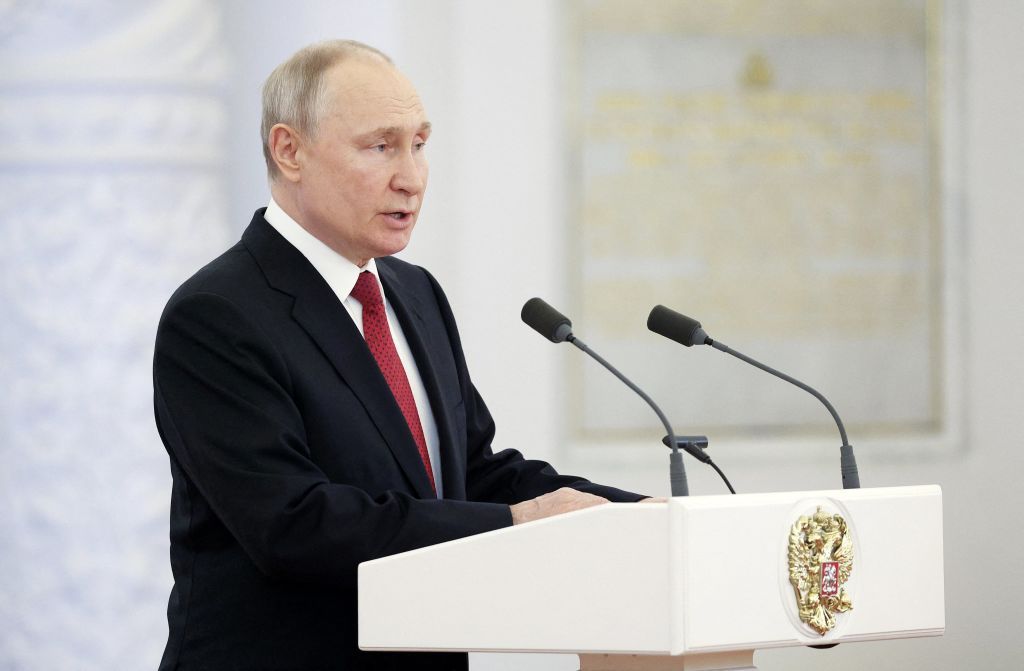
 kyivindependent.com
kyivindependent.com
Last week mexico invite putin for the inauguration. Mexico is long friend of Russia. Obrador friend of putin too. Sheinbaum is obradors heir, she will be good for russia and putin too.
Sheinbaum is the first leader to defy ICC arrest warrant.

Mexican president says authorities cannot arrest Putin in case of his visit
Lopez Obrador confirmed that the authorities had sent invitations to Sheinbaum's inauguration to the heads of all countries with which Mexico has diplomatic relations

Sheinbaum to foster ties between Russia, Mexico, Putin hopes
The Russian leader wished his future counterpart "every success in the government activity as well as health and prosperity"
Also neo nazis in Kiev want sheinbaum to arrest Putin this is not going to happen!

Ukraine requests Mexico arrest Putin if he attends inauguration
The Ukrainian embassy in Mexico on Aug. 7 asked the Mexican government to arrest Russian leader Vladimir Putin if he attends the inauguration of president-elect Claudia Sheinbaum.
Everything in this world is so whiny and jewish. No class, no civility, no beauty, no ascesis, just jewish ugliness.Sheinbaum putin relation off to a very good start.
Last week mexico invite putin for the inauguration. Mexico is long friend of Russia. Obrador friend of putin too. Sheinbaum is obradors heir, she will be good for russia and putin too.
Sheinbaum is the first leader to defy ICC arrest warrant.

Mexican president says authorities cannot arrest Putin in case of his visit
Lopez Obrador confirmed that the authorities had sent invitations to Sheinbaum's inauguration to the heads of all countries with which Mexico has diplomatic relationstass.com

Sheinbaum to foster ties between Russia, Mexico, Putin hopes
The Russian leader wished his future counterpart "every success in the government activity as well as health and prosperity"tass.com
Also neo nazis in Kiev want sheinbaum to arrest Putin this is not going to happen!

Ukraine requests Mexico arrest Putin if he attends inauguration
The Ukrainian embassy in Mexico on Aug. 7 asked the Mexican government to arrest Russian leader Vladimir Putin if he attends the inauguration of president-elect Claudia Sheinbaum.kyivindependent.com
What is Mexico now but a minority of jews controlling the bloodthirsty aztec dope hordes? All theater man. Too many people goyslopping it up like it's the last ice cream cone on earth.
Most people don’t live with greater awareness or purpose, but just live day to day, sleepwalking through life. Complaining, being weak, and living with a sense of innate scarcity is how TBTB want us to exist.Everything in this world is so whiny and jewish. No class, no civility, no beauty, no ascesis, just jewish ugliness.
What is Mexico now but a minority of jews controlling the bloodthirsty aztec dope hordes? All theater man. Too many people goyslopping it up like it's the last ice cream cone on earth.
All the fuzz about Bangladesh seems to be gone. Suddenly all the usual suspects screaming 'COLOUR REVOLUTION' on the top of their lungs backed off. I follow quite a few Indian channels on TG, and it's truly like a lightswitch.
Right now everybody is pandering to Yunus, who is supposedly just an advisor but from the looks of it runs the show. The Indians, Americans, Russians and Chinese all seem to be interested in improving their position in Bangladesh so there must be some bidding going on behind the scenes.
Just an example. The Russian Prime Minister (((Mishustin))) congratulated Yunus on his new job, and China's main Twitter propaganda channel called the deposed leader Hasina a political stooge who was toppled by 'the people'. Couple of days ago Indian leader Modi also received a phone call from Yunus wherein continued mutual cooperation was discussed.

In his first international performance Mohammed Yunus attended the online and Indian organized. Voice of the Global South summit. Yunus can be seen in the top right corner
One more thing, Bangladesh is facing some of its worst floods in decades. Ordinary Bengali are accusing India of being the culprit as an alleged dam has been opened. Indians deny. Not irrelevant: large parts of India's Tripura state are under water too.
Right now everybody is pandering to Yunus, who is supposedly just an advisor but from the looks of it runs the show. The Indians, Americans, Russians and Chinese all seem to be interested in improving their position in Bangladesh so there must be some bidding going on behind the scenes.
Just an example. The Russian Prime Minister (((Mishustin))) congratulated Yunus on his new job, and China's main Twitter propaganda channel called the deposed leader Hasina a political stooge who was toppled by 'the people'. Couple of days ago Indian leader Modi also received a phone call from Yunus wherein continued mutual cooperation was discussed.

In his first international performance Mohammed Yunus attended the online and Indian organized. Voice of the Global South summit. Yunus can be seen in the top right corner
One more thing, Bangladesh is facing some of its worst floods in decades. Ordinary Bengali are accusing India of being the culprit as an alleged dam has been opened. Indians deny. Not irrelevant: large parts of India's Tripura state are under water too.
One more thing, Bangladesh is facing some of its worst floods in decades. Ordinary Bengali are accusing India of being the culprit as an alleged dam has been opened. Indians deny. Not irrelevant: large parts of India's Tripura state are under water too.
Regional rivalry trumps the climate change drumbeat.
Judge Napolitano interviews Dr. Gilbert Doctorow re: Russian sentiment and current geopolitics. Of note, the US aircraft carriers in the Middle East might be at this location to conduct a first-strike against Russia, not necessarily Iran. How they can range to Russia, he does not say (and mistakenly claims they are in the Med). He notes that Russia believes it should first-strike the US mainland if they deem necessary, hence all the recent talk about reformulating Russian nuke policy. Backdrop for this concern are the otherwise inexplicable Ukrainian strikes on ICBM early warning radar sites this summer in southern Russia. Doctorow also cites Russian Deputy Foreign Minister Ryabkov as a hawk that is alerting on such matters. Also, Russian Duma member Kincevich, a respected national defense figure, has similar sentiment about the nuclear threat (and also remarks candidly on Russian weaknesses in the war).
Lavrov this week commented that the US is like a child playing with matches, callous to the nuclear threat for all of Europe, believing it will never be exposed to that threat from such a distance. He is laying the groundwork for Russia to re-think her no-first-strike nuke policy.
Things are getting interesting in Turkey.
Turkey has applied to join BRICS.
US Marines accosted and abused on the streets of Izmir.
Protests on the streets of Turkey against "Yankees".
My gut tells me that Turkey is not long for NATO...and that might set off a chain of events perhaps Biblical in consequence. There are prophecies by Orthodox Saints about just such events.
Turkey has applied to join BRICS.
US Marines accosted and abused on the streets of Izmir.
Protests on the streets of Turkey against "Yankees".
My gut tells me that Turkey is not long for NATO...and that might set off a chain of events perhaps Biblical in consequence. There are prophecies by Orthodox Saints about just such events.
forabettertomorrow
Orthodox
Things are getting interesting in Turkey.
Turkey has applied to join BRICS.
US Marines accosted and abused on the streets of Izmir.
Protests on the streets of Turkey against "Yankees".
My gut tells me that Turkey is not long for NATO...and that might set off a chain of events perhaps Biblical in consequence. There are prophecies by Orthodox Saints about just such events.
My friend this is youth union of Türkiye. They are Socialist anti imperialist group, good friends of Russia
They put sacks on head of us sailors since 2004. They often have big fight with Türkiye police. All people in video now arrested

Socialist, nationalist youth place sack on American soldier’s head in Izmir - Türkiye Today
Members of the Turkish Youth Union put sack over an American soldier’s head in protest against relentless Israeli atrocities in Gaza and decades-long 'US imperialism'

